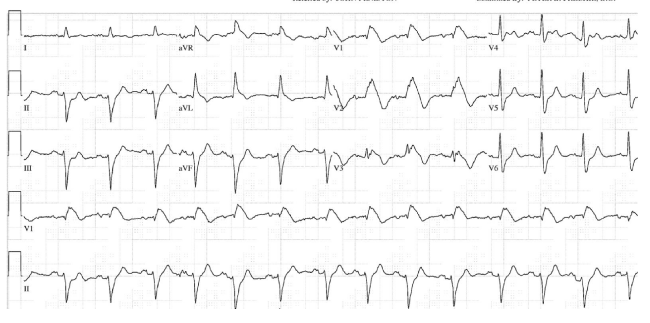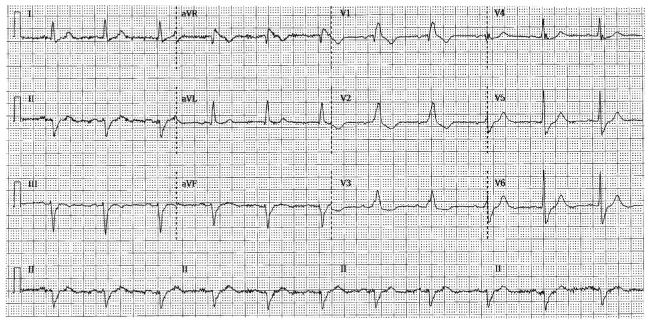Annals of Circulation
Fever Induced Brugada Syndrome
Aditya A Munshi*
Cite this as
Munshi AA (2017) Fever Induced Brugada Syndrome. Ann Circ 2(2): 024-025. DOI: 10.17352/ac.000008Dear Editor
Brugada syndrome is a heterogeneous genetic channelopathy that predisposes to ventricular arrhythmias and sudden cardiac death (SCD). The electrocardiogram (ECG) findings only suggest a diagnosis of Brugada syndrome but are not confirmatory. The ECG pattern is known to vary with time in some patients and many have a normal baseline ECG [1,2]. There are two distinctly described ECG patterns, type I Brugada is characterized by ST elevation (≥2mm) with a “coved” pattern or a T-wave which is inverted with an upward convexity, in other cases the elevated ST segment descends and rises again forming a “saddleback” type pattern, this is called the type II Brugada. The electrophysiological and clinical manifestations of this syndrome have been found to be secondary to various factors [3-10]. Of these, mutations in cardiac sodium channel SCN genes (SCN5A and SCN10A) are the most well-known [11]. Since all affected families do not have these mutations, it is believed that other mutations in sodium channel genes or mutations in non-sodium channel genes may also cause Brugada syndrome [12-15].
There have been some cases with a normal baseline EKG where in a Brugada pattern was induced by factors such fever, infection, cocaine use and even medication, particularly sodium channel blocking agents. With SCD being a common presenting symptom, it is critical to make an early diagnosis and institute preventive treatment such as an implantable cardioverter defibrillator. Our case described below is of a patient who presented to the emergency room (ER) with a fever and was found to have a pattern of ST elevation without any other cardiac symptoms.
The patient is a 71 year old male who presented to the emergency room with fever (103.5 F). An ER ECG (Figure 1) showed RBBB, coved ST elevation in leads V1-V4 with T-inversion characteristic of Type I Brugada syndrome. He was urgently taken for left heart catheterization, which revealed normal coronaries. An echocardiogram performed two days after this showed normal left and right ventricular funct ion. His EKG went back to his baseline pattern of RBBB/LAFB after fever resolution (Figure 2) and a diagnosis of type I Brugada syndrome unmasked in the setting of fever was made. He was offered defibrillator implantation, but he opted for conservative management.
Upon asking for a prior history of syncope, he reported two events; one when he was seventeen and another in his thirties. Both times he was in a hot environment and experienced a prodrome of feeling confined and crowded before briefly losing consciousness, suggestive of a vasovagal etiology and did not seek medical attention at the time.
Brugada syndrome triggered by fever is known to predispose to malignant ventricular arrhythmias. Other factors known to induce a Brugada pattern include cocaine, electrolyte imbalances, drug overdose and medication affecting sodium channels. Several cases similar to the one described here have been shown to be triggered by fever. One study showed that such patients are at a very high risk of developing malignant ventricular tachycardia during the same acute event that triggered the Brugada pattern ECG changes [8]. With this mode of presentation that can be fatal, it is imperative that such patients are treated for fever or taken off the offending medication as soon as a Brugada pattern is identified. With the syndrome being a genetically inherited entity, screening and education of family members in the risks and causative factors must be included along with treatment of the affected patient.
- Cerrato N, Giustetto C, Gribaudo E, Richiardi E, Barbonaglia L, et al. (2015) Prevalence of type 1 brugada electrocardiographic pattern evaluated by twelve-lead twenty-four-hour holter monitoring. The American journal of cardiology 115: 52-56. Link: https://goo.gl/WWJrUd
- Veltmann C, Schimpf R, Echternach C, Eckardt L, Kuschyk J, et al. (2006) A prospective study on spontaneous fluctuations between diagnostic and non-diagnostic ECGs in Brugada syndrome: implications for correct phenotyping and risk stratification. European heart journal 27: 2544-2552 . Link: https://goo.gl/v7vWkH
- Adler A, Topaz G, Heller K, Zeltser D, Ohayon T, et al. (2013) Fever-induced Brugada pattern: how common is it and what does it mean? Heart rhythm 10: 1375-1382 . Link: https://goo.gl/LNyz29
- Ching S, Yue CS (2015) Fever-induced Brugada Pattern. The American journal of medicine . Link: https://goo.gl/Y9pkh1
- Gandhi S, Kuo A, Smaggus A (2013) The management of Brugada syndrome unmasked by fever in a patient with cellulitis. BMJ case reports . Link: https://goo.gl/vGUqHU
- Grogan SP, Cube RP, Edwards JA (2011) Brugada syndrome unmasked by fever. Military medicine 176: 946-949 . Link: https://goo.gl/oijgS3
- Hilal T, Woods R (2015) A tick-borne illness unmasking asymptomatic Brugada syndrome. Oxford medical case reports; 191-193 . Link:
- Junttila MJ, Gonzalez M, Lizotte E, Benito B, Vernooy K, et al. (2008) Induced Brugada-type electrocardiogram, a sign for imminent malignant arrhythmias. Circulation; 117: 1890-1893 . Link: https://goo.gl/pySwPZ
- Madeira M, Caetano F, Providencia R, Almeida I, Trigo J, et al. (2015) Fever-induced type 1 Brugada pattern. Revista portuguesa de cardiologia: orgao oficial da Sociedade Portuguesa de Cardiologia = Portuguese journal of cardiology: an official journal of the Portuguese Society of Cardiology 34: 1-7 . Link: https://goo.gl/pPfTZU
- Tadin D, Quintal R (2017) Fever-Induced Brugada Pattern Misdiagnosed as an Acute Myocardial Infarction. The Journal of the Louisiana State Medical Society: official organ of the Louisiana State Medical Society 169: 11-14 . Link: https://goo.gl/DLBRRx
- Priori SG, Wilde AA, Horie M, Cho Y, Behr ER, et al. (2013) HRS/EHRA/APHRS expert consensus statement on the diagnosis and management of patients with inherited primary arrhythmia syndromes: document endorsed by HRS, EHRA, and APHRS in May 2013 and by ACCF, AHA, PACES, and AEPC in June 2013. Heart rhythm 10: 1932-1963 . Link: https://goo.gl/hHi7Mu
- Antzelevitch C, Pollevick GD, Cordeiro JM, Casis O, Sanguinetti MC, et al. (2007) Loss-of-function mutations in the cardiac calcium channel underlie a new clinical entity characterized by ST-segment elevation, short QT intervals, and sudden cardiac death. Circulation 115: 442-449. Link: https://goo.gl/AZytma
- Delpon E, Cordeiro JM, Nunez L, Thomsen PE, Guerchicoff A, et al. (2008) Functional effects of KCNE3 mutation and its role in the development of Brugada syndrome. Circulation Arrhythmia and electrophysiology 1: 209-218 . Link: https://goo.gl/FdiF7U
- Weiss R, Barmada MM, Nguyen T, Seibel JS, Cavlovich D, et al. (2002) Clinical and molecular heterogeneity in the Brugada syndrome: a novel gene locus on chromosome 3. Circulation 105: 707-713 . Link: https://goo.gl/a4MFwz
- Wu J, Shimizu W, Ding WG, Ohno S, Toyoda F, et al. (2010) KCNE2 modulation of Kv4.3 current and its potential role in fatal rhythm disorders. Heart rhythm 7: 199-205. Link: https://goo.gl/fW9mHy
Article Alerts
Subscribe to our articles alerts and stay tuned.
 This work is licensed under a Creative Commons Attribution 4.0 International License.
This work is licensed under a Creative Commons Attribution 4.0 International License.



 Save to Mendeley
Save to Mendeley
